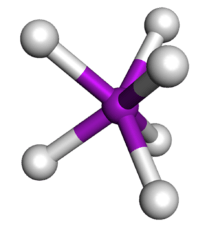Trigonal prismatic molecular geometry
| Trigonal prismatic molecular geometry | |
|---|---|
 | |
| Examples | W(CH3)6 |
| Steric number | 6 |
| Coordination number | 6 |
| Bond angle(s) | 95°, 85° |
| μ (Polarity) | 0 |
In chemistry, the trigonal prismatic molecular geometry describes the shape of compounds where six atoms, groups of atoms, or ligands are arranged around a central atom, defining the vertices of a triangular prism.
Examples
Hexamethyltungsten (W(CH3)6) was the first example of a molecular trigonal prismatic complex.[1]
Some other transition metals have trigonal prismatic hexamethyl complexes, including both neutral molecules such as Mo(CH3)6 and Re(CH3)6 and ions such as Ta(CH
3)−
6 and Zr(CH
3)2−
6.[2]
The complex Mo(S−CH=CH−S)3 is also trigonal prismatic, with each S−CH=CH−S group acting as a bidentate ligand with two sulfur atoms binding the metal atom.[2] Here the coordination geometry of the six sulfurs around the molybdenum is similar to that in the extended structure of molybdenum disulfide (MoS2).